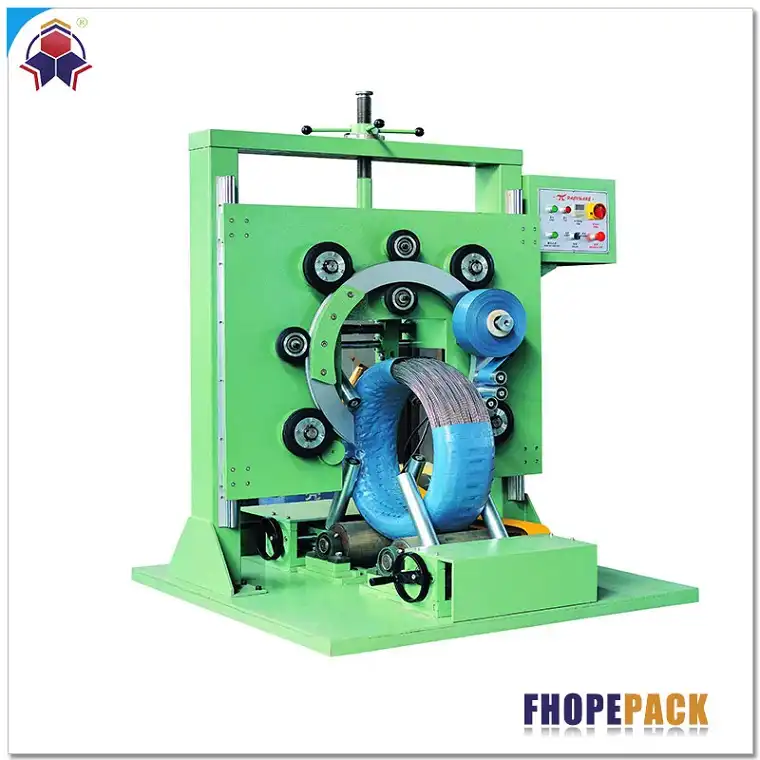Mastering Small Coil Packaging: The Role of Vertical Wrapping Machines
Efficiently and securely packaging small coils – whether they are wire, cable, hose, or other materials – presents unique challenges in manufacturing and distribution. Ensuring product integrity, preventing damage during transit, and optimizing handling requires specialized solutions. Vertical coil wrapping machines offer an automated, effective method specifically designed for these smaller, often unstable, cylindrical products.
This article delves into the functionality, benefits, and key considerations surrounding vertical coil wrapping machines designed for small package applications, providing insights for operations seeking to enhance their packaging processes.
What Exactly is a Vertical Coil Wrapping Machine for Small Packages?
A Vertical Coil Wrapping Machine for Small Packages is an automated packaging system engineered to apply protective materials, typically stretch film, around the outer diameter of small coils while they are oriented vertically (eye-to-the-sky). This orientation is often advantageous for smaller or lighter coils that might be unstable or difficult to handle when laid flat. The machine automates a process that would otherwise be labor-intensive and potentially inconsistent if done manually.
How Does the Vertical Wrapping Process Work?
While specific designs vary, the typical operational sequence involves:

- Loading: Coils are fed onto the machine's conveyor system, often automatically or semi-automatically, and positioned correctly within the wrapping station.
- Wrapping Cycle Initiation: Sensors detect the coil's presence and dimensions, initiating the automated wrapping cycle based on pre-programmed parameters.
- Film Application: A wrapping ring or shuttle carrying the packaging material (e.g., stretch film) orbits vertically around the stationary or slowly rotating coil. The film is applied under controlled tension, securely encasing the product.
- Film Cutting and Securing: Once the required number of wraps is applied, the machine automatically cuts the film and typically wipes it down against the coil to ensure it adheres properly.
- Unloading: The wrapped coil is automatically conveyed out of the wrapping station, ready for downstream processes like labeling, palletizing, or shipping.
Key Features and Capabilities Driving Efficiency
Modern vertical coil wrappers for small packages incorporate several features crucial for performance and reliability:
- Vertical Orientation Advantage: Ideal for handling small-diameter, narrow, or lightweight coils that benefit from being wrapped in an upright position, enhancing stability during the process.
- Automated Wrapping Cycle: Ensures consistent wrap quality, tension, and overlap, minimizing material waste and providing uniform package protection cycle after cycle. This automation significantly reduces the need for manual intervention.
- Adjustable Wrapping Parameters: Operators can easily adjust critical settings via a Human-Machine Interface (HMI), including:
- Film tension control
- Wrapping speed (ring rotation)
- Film overlap percentage
- Number of top and bottom wraps
- Coil rotation speed (if applicable)
This flexibility allows optimization for different coil sizes, weights, and required protection levels.
- Integrated Conveyor Systems: Roller or belt conveyors seamlessly transport coils into and out of the wrapping zone, facilitating integration into existing production or packaging lines. Customization accommodates various coil dimensions.
- Programmable Logic Controller (PLC): The machine's brain allows for storing multiple wrapping "recipes" for different products, enabling quick changeovers and precise control over the entire operation.
- Advanced Safety Mechanisms: Equipped with safety features compliant with industry standards (e.g., CE, OSHA), including light curtains, safety fencing, emergency stop buttons, and interlocked access doors to protect operators.
- User-Friendly Interface (HMI): Touch-screen controls provide intuitive operation, parameter adjustments, recipe management, and diagnostic feedback, simplifying use and maintenance.
- Material Versatility: While primarily used with stretch film, some machines can be adapted to apply other materials like VCI (Volatile Corrosion Inhibitor) film or paper for specific protection needs.
Significant Benefits for Small Coil Packaging Operations

Implementing a vertical coil wrapping machine yields substantial advantages:
- Enhanced Product Protection: Tightly applied film shields coils from dust, moisture, dirt, and abrasion during handling, storage, and shipping.
- Improved Load Stability: Securely unitizes the coil, preventing unraveling and maintaining its shape, crucial for subsequent handling or palletizing.
- Increased Throughput and Efficiency: Automation drastically speeds up the packaging process compared to manual methods, boosting overall line productivity.
- Reduced Labor Costs: Frees up personnel previously assigned to manual wrapping tasks for more value-added activities.
- Optimized Material Consumption: Precise control over film stretch and application minimizes waste, leading to cost savings on consumables.
- Professional Package Appearance: Delivers consistent, neat, and professional-looking packages every time, enhancing brand perception.
Common Industry Applications
These machines are vital in sectors dealing with small coiled products, including:
- Wire and Cable: Wrapping coils of electrical wire, communication cable, and fiber optics.
- Hose and Tubing: Packaging coils of rubber, plastic, or hydraulic hoses and tubing.
- Metals: Securing small coils of strip steel, aluminum wire, or other metals.
- Plastics: Wrapping coils of extruded profiles or filaments.
- Bearings and Rings: Unitizing smaller bearings or ring-shaped components.
Selecting the Right Machine: Key Considerations
When evaluating vertical coil wrappers, consider:
- Coil Specifications: Minimum/maximum Inner Diameter (ID), Outer Diameter (OD), width, and weight.
- Throughput Requirements: Required packages per hour/shift to match production rates.
- Packaging Material: Type of film or other material needed (stretch, VCI, paper).
- Automation Level: Degree of integration required with upstream and downstream equipment.
- Footprint and Layout: Available space and compatibility with existing line configuration.
- Budget and ROI: Initial investment versus long-term savings in labor and materials.
- Vendor Support: Availability of technical support, spare parts, and service.
Conclusion
Vertical coil wrapping machines for small packages represent a significant technological advancement for industries handling coiled products. By automating the wrapping process with precision and consistency, these machines deliver enhanced product protection, improved operational efficiency, reduced costs, and superior package quality. For manufacturers looking to optimize their small coil packaging operations, investing in the right vertical wrapping solution is a strategic move towards greater productivity and competitiveness.